Beyond Innovation Niches: A Social Sciences Review of System Building Perspectives in Sustainability Transitions
Abstract
1. Introduction
2. Materials and Methods
2.1. Constitution of the Corpus
2.1.1. Database Selection
2.1.2. Defining the Search Period
2.1.3. Keyword Selection and Search Strategy
- System-related terms: system OR regime OR stabilization OR alignment
- Development-related terms: build* OR design
- Transition-related terms: transition OR transformation
- Sustainability-related terms: sustainab*
- Challenge-related terms: lock-in OR uncertainties
2.1.4. Literature Assessment: Inclusion and Exclusion Criteria
2.2. Statistical and Lexicometric Analysis
2.2.1. Preprocessing and Text Standardization
2.2.2. Lexical Analysis and Visualization
2.2.3. Descending Hierarchical Classification (DHC)
2.3. Qualitative Analysis of Abstracts
3. Results from the Corpus-Based Lexicometric Analysis
3.1. Statistical Analysis
3.2. Similarity Analysis
3.3. Textual Analysis
4. Discussion
4.1. Key Concepts Characterizing Sustainability Transitions in Food and Energy Literature: Overlaps and Distinctions
4.2. System Building Perspectives in Food and Energy System Transitions
5. Conclusions and Future Directions
5.1. Conclusions
5.2. Future Directions
Author Contributions
Funding
Institutional Review Board Statement
Informed Consent Statement
Data Availability Statement
Acknowledgments
Conflicts of Interest
Appendix A
| References | Scale | Innovation | Lock-In | System | Uncertainty | Transition | Transformation/Change | Policy/Governance | Design | Future |
|---|---|---|---|---|---|---|---|---|---|---|
| Auvinen et al./2023 [64] | Finland | X | X | X | X | X | X | |||
| Biddau, Rizzoli, Sarrica/2024 [80] | Italy | X | X | X | ||||||
| Blumberga, Gravelsins, Blumberga/2022 [81] | Russia | X | X | X | X | |||||
| Bolton, Foxon, Hall/2016 [49] | United Kingdom | X | X | X | X | X | X | |||
| Castrejon-Campos, Aye, Hui/2020 [78] | / | X | X | X | X | X | X | |||
| Chilvers, Longhurst/2016 [53] | United Kingdom | X | X | X | ||||||
| Chilvers et al./2017 [65] | United Kingdom | X | X | X | X | X | ||||
| De Laurentis, Pearson/2021 [41] | Italy, Wales, Scotland | X | X | X | X | |||||
| Fisch-Romito et al./2021 [60] | Review | X | X | X | ||||||
| Floyd et al./2020 [73] | / | X | X | X | X | |||||
| Hall et al./2020 [70] | United Kingdom | X | X | X | ||||||
| Hall et al./2022 [46] | / | X | X | X | X | X | X | |||
| Hansen et al./2017 [82] | Denmark, Norway, Finland, Sweden | X | X | X | ||||||
| Heitmann, Pahl-Wostl, Engel/2019 [30] | / | X | X | X | ||||||
| Herreras Martínez et al./2022 [83] | Netherlands | X | X | X | X | X | ||||
| Iskandarova et al./2022 [66] | France, Switzerland, Great Britain | X | X | X | X | X | ||||
| Kivimaa et al./2022 [51] | / | X | X | X | X | X | X | |||
| Kloppenburg, Boekelo/2019 [40] | / | X | X | X | X | X | X | X | ||
| Knight, Pfeiffer, Scott/2015 [48] | / | X | X | X | X | |||||
| Koese et al./2022 [84] | / | X | X | X | X | X | X | |||
| Korkmaz, Schmid, Fahl/2021 [71] | / | X | X | X | X | X | X | |||
| Kusumaningdyah, Tezuka, McLellan/2021 [85] | / | X | X | X | X | X | ||||
| Lennon, Dunphy, Sanvicente/2019 [67] | France, Ireland, Italy, Spain, United Kingdom | X | X | X | X | X | X | |||
| Li, Trutnevyte, Strachan/2015 [45] | Review | X | X | X | X | X | ||||
| Li, Strachan/2017 [38] | / | X | X | X | X | X | X | |||
| Li, Trutnevyte/2017 [55] | / | X | X | X | X | X | ||||
| Löhr, Mattes/2022 [42] | Germany | X | X | X | X | X | ||||
| Malz et al./2023 [61] | China, Pakistan, Mozambique | X | X | X | ||||||
| Metze et al./2023 [86] | Netherlands | X | X | X | X | |||||
| Moallemi et al./2017 [39] | India | X | X | X | X | |||||
| Mossberg, Söderholm, Frishammar/2021 [63] | Sweden | X | X | X | X | X | ||||
| Muldoon-Smith, Greenhalgh/2019 [87] | United Kingdom | X | X | X | X | |||||
| Muza, Debnath/2021 [69] | Rwanda | X | X | X | X | |||||
| Nik, Perera, Chen/2021 [57] | Review | X | X | X | X | X | ||||
| Nwanekezie, Noble, Poelzer/2022 [54] | Canada | X | X | X | X | X | ||||
| Oshiro, Fujimori/2021 [88] | Japan | X | X | X | X | |||||
| Pahker et al./2024 [47] | Estonia | X | X | X | X | X | X | X | ||
| Paredes-Vergara, Palma-Behnke, Haas/2024 [74] | Review | X | X | |||||||
| Pereira et al./2018 [62] | Germany, Portugal | X | X | X | X | X | ||||
| Purkus, Gawel, Thrän/2017 [89] | Germany, Europe | X | X | X | X | X | X | X | ||
| Reda et al./2021 [90] | Finland | X | X | X | X | X | X | |||
| Rootzén et al./2023 [91] | / | X | X | X | ||||||
| Seto et al./2016 [92] | Review | X | X | X | X | |||||
| Sgarbossa et al./2023 [52] | Review | X | X | X | X | X | ||||
| Skoczkowski et al./2018 [50] | Poland | X | X | X | X | X | X | X | ||
| Speich, Chambers, Ulli-Beer/2024 [93] | Switzerland | X | X | X | X | X | ||||
| Van Opstal, Smeets/2022 [72] | Belgium | X | X | X | X | X | ||||
| Verrier, Strachan/2024 [44] | / | X | X | X | ||||||
| Vishwanathan, Garg/2020 [94] | India | X | X | |||||||
| Weiser et al./2017 [58] | / | X | X | X | ||||||
| Weko, Goldthau/2022 [68] | Global South | X | X | X | X | X | ||||
| Werner, Lazaro/2023 [43] | Brazil | X | X | X | X | X | X | |||
| Wolsink/2020 [59] | Review | X | X | X | X | X | X | |||
| Xexakis et al./2020 [95] | Switzerland | X | X | X | X | |||||
| Zhao, You/2021 [56] | United States of America | X | X | X |
| References | Scale | Innovation | Lock-In | System | Collaboration | Uncertainty | Transition | Transformation/Change | Policy/Governance | Design | Future |
|---|---|---|---|---|---|---|---|---|---|---|---|
| Baret/2017 [96] | Belgium | X | X | X | X | ||||||
| Boulestreau, Casagrande, Navarrete/2021 [26] | France | X | X | X | X | X | X | X | |||
| Boulestreau et al./2022 [28] | France | X | X | X | X | X | X | X | |||
| Boulestreau, Casagrande, Navarrete/2023 [27] | France | X | X | X | X | X | X | ||||
| Cholez, Magrini/2023 [97] | Europe | X | X | X | |||||||
| Contesse et al./2024 [98] | Chile | X | X | X | X | ||||||
| Dagli/2022 [35] | Philippines | X | X | X | X | ||||||
| Della Rossa et al./2020 [31] | Martinique | X | X | X | X | X | X | ||||
| Drottberger, Melin, Lundgren/2021 [99] | Sweden | X | X | X | X | ||||||
| Duru, Therond, Fares/2015 [29] | Review | X | X | X | X | X | X | X | |||
| Griffon, Hernandez, Ramírez/2021 [100] | / | X | X | X | |||||||
| Heitmann, Pahl-Wostl, Engel/2019 [30] | Germany | X | X | X | X | ||||||
| Hoogstra et al./2024 [25] | Netherlands | X | X | ||||||||
| Kuokkanen et al./2017 [101] | Finland | X | X | X | X | X | X | ||||
| Leclère, Loyce, Jeuffroy/2023 [37] | France | X | X | X | X | ||||||
| Lluch-Cota, del Monte-Luna, Gurney-Smith/2023 [102] | / | X | X | X | X | X | X | ||||
| Meynard et al./2017 [32] | / | X | X | X | X | X | |||||
| Meynard et al./2018 [33] | France | X | X | X | X | ||||||
| Morel et al./2020 [103] | Europe | X | X | X | X | X | |||||
| Navarro Garcia et al./2023 [24] | Australia | X | X | X | X | ||||||
| Palmer, Burton, Gottschamer/ 2022 [104] | / | X | X | X | X | ||||||
| Perrin et al./2023 [34] | Review | X | X | X | X | X | |||||
| Prosperi et al./2020 [105] | Italy | X | X | X | |||||||
| Prost et al./2023 [106] | Review | X | X | X | X | X | X | ||||
| Revoyron et al./2022 [36] | France, Italy, Sweden | X | X | X | |||||||
| Schmid et al./2024 [107] | Western Europe | X | X | X | X | X | |||||
| Toffolini, Jeuffroy, Prost/2015 [108] | France | X | X | X | |||||||
| Vermunt et al./2022 [109] | Netherlands | X | X | X | X |
References
- Adloff, F.; Neckel, S. Futures of Sustainability as Modernization, Transformation, and Control: A Conceptual Framework. Sustain. Sci. 2019, 14, 1015–1025. [Google Scholar] [CrossRef]
- Hamman, P.; Anquetin, V.; Monicolle, C. Contemporary Meanings of the ‘Sustainable City’: A Comparative Review of the French- and English-Language Literature. Sustain. Dev. 2017, 25, 336–355. [Google Scholar] [CrossRef]
- Hamman, P. (Ed.) Cross-Border Renewable Energy Transitions: Lessons from Europe’s Upper Rhine Region; Routledge: Abingdon, UK; New York, NY, USA, 2022. [Google Scholar]
- Commaille, J.; Simoulin, V.; Thoemmes, J. Les temps de l’action publique entre accélération et hétérogénéité. Temporalités 2014, 19, 105–124. [Google Scholar] [CrossRef]
- Levy, L. L’action sur les territoires face au défi d’une temporalité ouverte. L’improvisation comme modèle pour l’action aménagiste? Dev. Durable Territ. 2018, 9, 1–17. [Google Scholar] [CrossRef]
- Geels, F.W. The Multi-Level Perspective on Sustainability Transitions: Responses to Seven Criticisms. Environ. Innov. Soc. Transit. 2011, 1, 24–40. [Google Scholar] [CrossRef]
- El Bilali, H. The Multi-Level Perspective in Research on Sustainability Transitions in Agriculture and Food Systems: A Systematic Review. Agriculture 2019, 9, 74. [Google Scholar] [CrossRef]
- Flood Chavez, D.; Niewiadomski, P.; Jones, T. From Niches to Regime: Sustainability Transitions in a Diverse Tourism Destination. Tour. Geogr. 2024, 26, 173–193. [Google Scholar] [CrossRef]
- Labussière, O.; Nadaï, A. (Eds.) Energy Transitions: A Socio-Technical Inquiry; Palgrave Macmillan: Basingstoke, UK, 2018. [Google Scholar]
- Malier, H. Greening the Poor: The Trap of Moralization. Br. J. Sociol. 2019, 70, 1661–1680. [Google Scholar] [CrossRef]
- Freytag, T.; Gössling, S.; Mössner, S. Living the Green City: Freiburg’s Solarsiedlung between Narratives and Practices of Sustainable Urban Development. Local Environ. 2014, 19, 644–659. [Google Scholar] [CrossRef]
- Köhler, J.; Geels, F.W.; Kern, F.; Markard, J.; Onsongo, E.; Wieczorek, A.; Alkemade, F.; Avelino, F.; Bergek, A.; Boons, F.; et al. An Agenda for Sustainability Transitions Research: State of the Art and Future Directions. Environ. Innov. Soc. Transit. 2019, 31, 1–32. [Google Scholar] [CrossRef]
- Olbrich, S.; Bauknecht, D. The System Building Perspective for Building Sustainable System Configurations Using the German Energy Transition as an Example. Oxf. Open Energy 2024, 3, oiae010. [Google Scholar] [CrossRef]
- Kanger, L.; Sovacool, B.K.; Noorkõiv, M. Six Policy Intervention Points for Sustainability Transitions: A Conceptual Framework and a Systematic Literature Review. Res. Policy 2020, 49, 104072. [Google Scholar] [CrossRef]
- Rogge, K.S.; Kern, F.; Howlett, M. Conceptual and Empirical Advances in Analysing Policy Mixes for Energy Transitions. Energy Res. Soc. Sci. 2017, 33, 1–10. [Google Scholar] [CrossRef]
- Hamman, P. (Ed.) Sustainability Governance and Hierarchy; Routledge: Abingdon, UK; New York, NY, USA, 2019. [Google Scholar]
- Bornemann, B.; Christen, M.; Burger, P. The Sustainable State: A Meta-Governance Framework. Environ. Politics 2025, 34, 344–366. [Google Scholar] [CrossRef]
- Robertson, M. Dictionary of Sustainability; Routledge: Abingdon, UK, 2017. [Google Scholar]
- Simoens, M.C.; Leipold, S.; Fuenfschilling, L. Locked in Unsustainability: Understanding Lock-Ins and Their Interactions Using the Case of Food Packaging. Environ. Innov. Soc. Transit. 2022, 45, 14–29. [Google Scholar] [CrossRef]
- Page, M.J.; McKenzie, J.E.; Bossuyt, P.M.; Boutron, I.; Hoffmann, T.C.; Mulrow, C.D.; Shamseer, L.; Tetzlaff, J.M.; Akl, E.A.; Brennan, S.E.; et al. The PRISMA 2020 Statement: An Updated Guideline for Reporting Systematic Reviews. BMJ 2021, 372, 71. [Google Scholar] [CrossRef]
- Reinert, M. Une méthode de classification descendante hiérarchique: Application à l’analyse lexicale par contexte. Cah. Anal. Données 1983, 8, 187–198. [Google Scholar]
- Marty, E. Les élections municipales au miroir de la presse quotidienne régionale. Des cadres médiatiques aux thématiques politiques. Mots. Lang. Pol. 2015, 108, 39–55. [Google Scholar] [CrossRef]
- Kalampalikis, N. L’apport de la méthode Alceste dans l’étude des représentations sociales. In Méthodes D’étude des Représentations Sociales; Abric, J.-C., Ed.; Érès: Toulouse, France, 2003; pp. 147–163. [Google Scholar]
- Navarro Garcia, J.; Marcos-Martinez, R.; Mosnier, A.; Schmidt-Traub, G.; Javalera Rincon, V.; Obersteiner, M.; Perez Guzman, K.; Thomson, M.J.; Penescu, L.; Douzal, C.; et al. Multi-Target Scenario Discovery to Plan for Sustainable Food and Land Systems in Australia. Sustain. Sci. 2023, 18, 371–388. [Google Scholar] [CrossRef]
- Hoogstra, A.G.; Silvius, J.; de Olde, E.M.; Candel, J.J.L.; Termeer, C.J.A.M.; van Ittersum, M.K.; de Boer, I.J.M. The Transformative Potential of Circular Agriculture Initiatives in the North of the Netherlands. Agric. Syst. 2024, 214, 103833. [Google Scholar] [CrossRef]
- Boulestreau, Y.; Casagrande, M.; Navarrete, M. Analyzing Barriers and Levers for Practice Change: A New Framework Applied to Vegetables’ Soil Pest Management. Agron. Sustain. Dev. 2021, 41, 44. [Google Scholar] [CrossRef]
- Boulestreau, Y.; Casagrande, M.; Navarrete, M. A Method to Design Coupled Innovations for the Agroecological Transition. Implementation for Soil Health Management in Provencal Sheltered Vegetable Systems. Agric. Syst. 2023, 212, 103752. [Google Scholar] [CrossRef]
- Boulestreau, Y.; Peyras, C.-L.; Casagrande, M.; Navarrete, M. Tracking down Coupled Innovations Supporting Agroecological Vegetable Crop Protection to Foster Sustainability Transition of Agrifood Systems. Agric. Syst. 2022, 196, 103354. [Google Scholar] [CrossRef]
- Duru, M.; Therond, O.; Fares, M. Designing Agroecological Transitions; A Review. Agron. Sustain. Dev. 2015, 35, 1237–1257. [Google Scholar] [CrossRef]
- Heitmann, F.; Pahl-Wostl, C.; Engel, S. Requirements Based Design of Environmental System of Systems: Development and Application of a Nexus Design Framework. Sustainability 2019, 11, 3464. [Google Scholar] [CrossRef]
- Della Rossa, P.; Le Bail, M.; Mottes, C.; Jannoyer, M.; Cattan, P. Innovations Developed within Supply Chains Hinder Territorial Ecological Transition: The Case of a Watershed in Martinique. Agron. Sustain. Dev. 2020, 40, 10. [Google Scholar] [CrossRef]
- Meynard, J.-M.; Jeuffroy, M.-H.; Le Bail, M.; Lefèvre, A.; Magrini, M.-B.; Michon, C. Designing Coupled Innovations for the Sustainability Transition of Agrifood Systems. Agric. Syst. 2017, 157, 330–339. [Google Scholar] [CrossRef]
- Meynard, J.-M.; Charrier, F.; Fares, M.; Le Bail, M.; Magrini, M.-B.; Charlier, A.; Messéan, A. Socio-Technical Lock-in Hinders Crop Diversification in France. Agron. Sustain. Dev. 2018, 38, 54. [Google Scholar] [CrossRef]
- Perrin, A.; Yannou-Le Bris, G.; Angevin, F.; Pénicaud, C. Sustainability Assessment in Innovation Design Processes: Place, Role, and Conditions of Use in Agrifood Systems. A Review. Agron. Sustain. Dev. 2023, 43, 10. [Google Scholar] [CrossRef]
- Dagli, W. “Central” and “Peripheral” Adaptation Pathways of Entangled Agrifood Systems Transformations. Front. Sustain. Food Syst. 2022, 6, 984276. [Google Scholar] [CrossRef]
- Revoyron, E.; Le Bail, M.; Meynard, J.-M.; Gunnarsson, A.; Seghetti, M.; Colombo, L. Diversity and Drivers of Crop Diversification Pathways of European Farms. Agric. Syst. 2022, 201, 103439. [Google Scholar] [CrossRef]
- Leclère, M.; Loyce, C.; Jeuffroy, M.-H. A Participatory and Multi-Actor Approach to Locally Support Crop Diversification Based on the Case Study of Camelina in Northern France. Agron. Sustain. Dev. 2023, 43, 13. [Google Scholar] [CrossRef]
- Li, F.G.N.; Strachan, N. Modelling Energy Transitions for Climate Targets Under Landscape and Actor Inertia. Environ. Innov. Soc. Transit. 2017, 24, 106–129. [Google Scholar] [CrossRef]
- Moallemi, E.A.; de Haan, F.; Kwakkel, J.; Aye, L. Narrative-Informed Exploratory Analysis of Energy Transition Pathways: A Case Study of India’s Electricity Sector. Energy Policy 2017, 110, 271–287. [Google Scholar] [CrossRef]
- Kloppenburg, S.; Boekelo, M. Digital Platforms and the Future of Energy Provisioning: Promises and Perils for the next Phase of the Energy Transition. Energy Res. Soc. Sci. 2019, 49, 68–73. [Google Scholar] [CrossRef]
- De Laurentis, C.; Pearson, P.J.G. Policy-Relevant Insights for Regional Renewable Energy Deployment. Energy Sustain. Soc. 2021, 11, 19. [Google Scholar] [CrossRef]
- Löhr, M.; Mattes, J. Facing Transition Phase Two: Analysing Actor Strategies in a Stagnating Acceleration Phase. Technol. Forecast. Soc. Change 2022, 174, 121221. [Google Scholar] [CrossRef]
- Werner, D.; Lazaro, L.L.B. The Policy Dimension of Energy Transition: The Brazilian Case in Promoting Renewable Energies (2000–2022). Energy Policy 2023, 175, 113480. [Google Scholar] [CrossRef]
- Verrier, B.; Strachan, N. Sunset and Sunrise Business Strategies Shaping National Energy Transitions. Renew. Sustain. Energy Rev. 2024, 195, 114330. [Google Scholar] [CrossRef]
- Li, F.G.N.; Trutnevyte, E.; Strachan, N. A Review of Socio-Technical Energy Transition (STET) Models. Technol. Forecast. Soc. Change 2015, 100, 290–305. [Google Scholar] [CrossRef]
- Hall, S.; Workman, M.; Hardy, J.; Mazur, C.; Anable, J.; Powell, M.; Wagner, S.M. Doing Business Model Innovation for Sustainability Transitions—Bringing in Strategic Foresight and Human Centred Design. Energy Res. Soc. Sci. 2022, 90, 102685. [Google Scholar] [CrossRef]
- Pahker, A.-K.; Keller, M.; Karo, E.; Vihalemm, T.; Solvak, M.; Orru, K.; Tammiksaar, E.; Ukrainski, K.; Noorkõiv, M. What’s Worse, Communism or Carbon? Using the Transitions Delphi Approach to Identify Viable Interventions for the Estonian Energy Transition. Energy Res. Soc. Sci. 2024, 109, 103421. [Google Scholar] [CrossRef]
- Knight, L.; Pfeiffer, A.; Scott, J. Supply Market Uncertainty: Exploring Consequences and Responses within Sustainability Transitions. J. Purch. Supply Manag. 2015, 21, 167–177. [Google Scholar] [CrossRef]
- Bolton, R.; Foxon, T.J.; Hall, S. Energy Transitions and Uncertainty: Creating Low Carbon Investment Opportunities in the UK Electricity Sector. Environ. Plann. C Gov. Policy 2016, 34, 1387–1403. [Google Scholar] [CrossRef]
- Skoczkowski, T.; Bielecki, S.; Węglarz, A.; Włodarczak, M.; Gutowski, P. Impact Assessment of Climate Policy on Poland’s Power Sector. Mitig. Adapt Strateg. Glob. Change 2018, 23, 1303–1349. [Google Scholar] [CrossRef]
- Kivimaa, P.; Brisbois, M.C.; Jayaram, D.; Hakala, E.; Siddi, M. A Socio-Technical Lens on Security in Sustainability Transitions: Future Expectations for Positive and Negative Security. Futures 2022, 141, 102971. [Google Scholar] [CrossRef]
- Sgarbossa, F.; Arena, S.; Tang, O.; Peron, M. Renewable Hydrogen Supply Chains: A Planning Matrix and an Agenda for Future Research. Int. J. Prod. Econ. 2023, 255, 108674. [Google Scholar] [CrossRef]
- Chilvers, J.; Longhurst, N. Participation in Transition(s): Reconceiving Public Engagements in Energy Transitions as Co-Produced, Emergent and Diverse. J. Environ. Policy Plan. 2016, 18, 585–607. [Google Scholar] [CrossRef]
- Nwanekezie, K.; Noble, B.; Poelzer, G. Strategic Assessment for Energy Transitions: A Case Study of Renewable Energy Development in Saskatchewan, Canada. Environ. Impact Assess. Rev. 2022, 92, 106688. [Google Scholar] [CrossRef]
- Li, F.G.N.; Trutnevyte, E. Investment Appraisal of Cost-Optimal and Near-Optimal Pathways for the UK Electricity Sector Transition to 2050. Appl. Energy 2017, 189, 89–109. [Google Scholar] [CrossRef]
- Zhao, N.; You, F. New York State’s 100% Renewable Electricity Transition Planning Under Uncertainty Using a Data-Driven Multistage Adaptive Robust Optimization Approach with Machine-Learning. Adv. Appl. Energy 2021, 2, 100019. [Google Scholar] [CrossRef]
- Nik, V.M.; Perera, A.T.D.; Chen, D. Towards Climate Resilient Urban Energy Systems: A Review. Natl. Sci. Rev. 2021, 8, nwaa134. [Google Scholar] [CrossRef]
- Weiser, A.; Lutz, L.M.; Lang, D.J.; Kümmerer, K. Acknowledging Temporal Diversity in Sustainability Transformations at the Nexus of Interconnected Systems. J. Clean. Prod. 2017, 162, 273–285. [Google Scholar] [CrossRef]
- Wolsink, M. Distributed Energy Systems as Common Goods: Socio-Political Acceptance of Renewables in Intelligent Microgrids. Renew. Sustain. Energy Rev. 2020, 127, 109841. [Google Scholar] [CrossRef]
- Fisch-Romito, V.; Guivarch, C.; Creutzig, F.; Minx, J.C.; Callaghan, M.W. Systematic Map of the Literature on Carbon Lock-in Induced by Long-Lived Capital. Environ. Res. Lett. 2021, 16, 053004. [Google Scholar] [CrossRef]
- Malz, N.; Corral Montoya, F.; Yanguas Parra, P.; Oei, P.-Y. China’s Climate and Energy Policy Paradox Revisited—Domestic and International Implications of a Carbon Lock-in ‘with Chinese Characteristics’. Energy Sources Part B Econ. Plan. Policy 2023, 18, 2166164. [Google Scholar] [CrossRef]
- Pereira, G.I.; Specht, J.M.; Silva, P.P.; Madlener, R. Technology, Business Model, and Market Design Adaptation Toward Smart Electricity Distribution: Insights for Policy Making. Energy Policy 2018, 121, 426–440. [Google Scholar] [CrossRef]
- Mossberg, J.; Söderholm, P.; Frishammar, J. Challenges of Sustainable Industrial Transformation: Swedish Biorefinery Development and Incumbents in the Emerging Biofuels Industry. Biofuels Bioprod. Biorefin. 2021, 15, 1264–1280. [Google Scholar] [CrossRef]
- Auvinen, K.; Meriläinen, T.; Saikku, L.; Hyysalo, S.; Juntunen, J.K. Accelerating Transition toward District Heating-System Decarbonization by Policy Co-Design with Key Investors: Opportunities and Challenges. Sustain. Sci. Pract. Policy 2023, 19, 2256622. [Google Scholar] [CrossRef]
- Chilvers, J.; Foxon, T.J.; Galloway, S.; Hammond, G.P.; Infield, D.; Leach, M.; Pearson, P.J.; Strachan, N.; Strbac, G.; Thomson, M. Realising Transition Pathways for a More Electric, Low-Carbon Energy System in the United Kingdom: Challenges, Insights and Opportunities. Proc. Inst. Mech. Eng. A 2017, 231, 440–477. [Google Scholar] [CrossRef]
- Iskandarova, M.; Vernay, A.-L.; Musiolik, J.; Müller, L.; Sovacool, B.K. Tangled Transitions: Exploring the Emergence of Local Electricity Exchange in France, Switzerland and Great Britain. Technol. Forecast. Soc. Change 2022, 180, 121677. [Google Scholar] [CrossRef]
- Lennon, B.; Dunphy, N.P.; Sanvicente, E. Community Acceptability and the Energy Transition: A Citizens’ Perspective. Energy Sustain. Soc. 2019, 9, 35. [Google Scholar] [CrossRef]
- Weko, S.; Goldthau, A. Bridging the Low-Carbon Technology Gap? Assessing Energy Initiatives for the Global South. Energy Policy 2022, 169, 113192. [Google Scholar] [CrossRef]
- Muza, O.; Debnath, R. Disruptive Innovation for Inclusive Renewable Policy in Sub-Saharan Africa: A Social Shaping of Technology Analysis of Appliance Uptake in Rwanda. Renew. Energy 2021, 168, 896–912. [Google Scholar] [CrossRef]
- Hall, S.; Mazur, C.; Hardy, J.; Workman, M.; Powell, M. Prioritising Business Model Innovation: What Needs to Change in the United Kingdom Energy System to Grow Low Carbon Entrepreneurship? Energy Res. Soc. Sci. 2020, 60, 101317. [Google Scholar] [CrossRef]
- Korkmaz, P.; Schmid, D.; Fahl, U. Incorporating Uncertainties Towards a Sustainable European Energy System: A Stochastic Approach for Decarbonization Paths Focusing on the Transport Sector. Energy Strategy Rev. 2021, 38, 100707. [Google Scholar] [CrossRef]
- Van Opstal, W.; Smeets, A. Market-Specific Barriers and Enablers for Organizational Investments in Solar PV—Lessons from Flanders. Sustainability 2022, 14, 13069. [Google Scholar] [CrossRef]
- Floyd, J.; Alexander, S.; Lenzen, M.; Moriarty, P.; Palmer, G.; Chandra-Shekeran, S.; Foran, B.; Keyßer, L. Energy Descent as a Post-Carbon Transition Scenario: How ‘Knowledge Humility’ Reshapes Energy Futures for Post-Normal Times. Futures 2020, 122, 102565. [Google Scholar] [CrossRef]
- Paredes-Vergara, M.; Palma-Behnke, R.; Haas, J. Characterizing Decision Making Under Deep Uncertainty for Model-Based Energy Transitions. Renew. Sustain. Energy Rev. 2024, 192, 114233. [Google Scholar] [CrossRef]
- Cotton, M.; Cooper, C.; Milner, J.; Towers, L. Hydrogen Innovation and Just Transitions: Exploring Sociotechnical Configurations of Energy Futures in a Post-Industrial Community. Energy Res. Soc. Sci. 2025, 127, 104181. [Google Scholar] [CrossRef]
- Chavot, P.; Masseran, A.; Serrano, Y.; Arnaud, J.; Zoungrana, J. Public Engagement, Changes in the Governance and the Requalification of High-Energy Geothermal Projects in France. In Geothermal Energy and Society: Theory, Methods and Applications; Manzella, A., Allansdottir, A., Pellizzone, A., Eds.; Springer Nature: Berlin/Heidelberg, Germany, 2025; pp. 165–194. [Google Scholar]
- Hamman, P.; Dziebowski, A. Building an Agricultural Biogas Supply Chain in Europe: Organizational Models and Social Challenges. Sustainability 2025, 17, 5806. [Google Scholar] [CrossRef]
- Castrejon-Campos, O.; Aye, L.; Hui, F.K.P. Making Policy Mixes More Robust: An Integrative and Interdisciplinary Approach for Clean Energy Transitions. Energy Res. Soc. Sci. 2020, 64, 101425. [Google Scholar] [CrossRef]
- Remy, J.; Blanc, M.; Foucart, J.; Stoessel-Ritz, J. La Transaction Tociale. Un Outil Pour Penser et Dénouer la Complexité de la vie en Société; Érès: Toulouse, France, 2020. [Google Scholar]
- Biddau, F.; Rizzoli, V.; Sarrica, M. Phasing-out ‘Coal Tradition’ in Favour of ‘Renewable Colonialism’: How the Press Contributes to the Discursive (de) Legitimization of Coal and Renewables in a Coal Region in Transition. Sustain. Sci. 2024, 19, 381–402. [Google Scholar] [CrossRef]
- Blumberga, A.; Gravelsins, A.; Blumberga, D. Deliberation Platform for Energy Transition Policies: How to Make Complex Things Simple. Energies 2022, 15, 90. [Google Scholar] [CrossRef]
- Hansen, T.; Klitkou, A.; Borup, M.; Scordato, L.; Wessberg, N. Path Creation in Nordic Energy and Road Transport Systems—The Role of Technological Characteristics. Renew. Sustain. Energy Rev. 2017, 70, 551–562. [Google Scholar] [CrossRef]
- Herreras Martínez, S.; Harmsen, R.; Menkveld, M.; Faaij, A.; Kramer, G.J. Municipalities as Key Actors in the Heat Transition to Decarbonise Buildings: Experiences from Local Planning and Implementation in a Learning Context. Energy Policy 2022, 169, 113169. [Google Scholar] [CrossRef]
- Koese, M.; Blanco, C.F.; Breeman, G.; Vijver, M.G. Towards a More Resource-Efficient Solar Future in the EU: An Actor-Centered Approach. Environ. Innov. Soc. Transit. 2022, 45, 36–51. [Google Scholar] [CrossRef]
- Kusumaningdyah, W.; Tezuka, T.; McLellan, B.C. Investigating Preconditions for Sustainable Renewable Energy Product–Service Systems in Retail Electricity Markets. Energies 2021, 14, 1877. [Google Scholar] [CrossRef]
- Metze, T.A.P.; van den Broek, J.; van Est, R.; Cuppen, E.H.W.J. Participatory Repertoires for Aligning Policy and Society: An Analysis of Dutch Stakeholder Views on Deep Geothermal Energy. Energy Res. Soc. Sci. 2023, 98, 103019. [Google Scholar] [CrossRef]
- Muldoon-Smith, K.; Greenhalgh, P. Suspect Foundations: Developing an Understanding of Climate-Related Stranded Assets in the Global Real Estate Sector. Energy Res. Soc. Sci. 2019, 54, 60–67. [Google Scholar] [CrossRef]
- Oshiro, K.; Fujimori, S. Stranded Investment Associated with Rapid Energy System Changes Under the Mid-Century Strategy in Japan. Sustain. Sci. 2021, 16, 477–487. [Google Scholar] [CrossRef]
- Purkus, A.; Gawel, E.; Thrän, D. Addressing Uncertainty in Decarbonisation Policy Mixes—Lessons Learned from German and European Bioenergy Policy. Energy Res. Soc. Sci. 2017, 33, 82–94. [Google Scholar] [CrossRef]
- Reda, F.; Ruggiero, S.; Auvinen, K.; Temmes, A. Towards Low-Carbon District Heating: Investigating the Socio-Technical Challenges of the Urban Energy Transition. Smart Energy 2021, 4, 100054. [Google Scholar] [CrossRef]
- Rootzén, J.; Nyberg, T.; Karltorp, K.; Åhman, M. Turning the Tanker? Exploring the Preconditions for Change in the Global Petrochemical Industry. Energy Res. Soc. Sci. 2023, 104, 103256. [Google Scholar] [CrossRef]
- Seto, K.C.; Davis, S.J.; Mitchell, R.B.; Stokes, E.C.; Unruh, G.; Ürge-Vorsatz, D. Carbon Lock-In: Types, Causes, and Policy Implications. Annu. Rev. Environ. Resour. 2016, 41, 425–452. [Google Scholar] [CrossRef]
- Speich, M.; Chambers, J.; Ulli-Beer, S. Current and Future Development of Thermal Grids in Switzerland: An Organizational Perspective. Front. Sustain. Cities 2024, 6, 1379554. [Google Scholar] [CrossRef]
- Vishwanathan, S.S.; Garg, A. Energy System Transformation to Meet NDC, 2 °C, and Well below 2 °C Targets for India. Clim. Change 2020, 162, 1877–1891. [Google Scholar] [CrossRef]
- Xexakis, G.; Hansmann, R.; Volken, S.P.; Trutnevyte, E. Models on the Wrong Track: Model-Based Electricity Supply Scenarios in Switzerland Are Not Aligned with the Perspectives of Energy Experts and the Public. Renew. Sustain. Energy Rev. 2020, 134, 110297. [Google Scholar] [CrossRef]
- Baret, P.V. Acceptance of Innovation and Pathways to Transition Towards More Sustainable Food Systems. Potato Res. 2017, 60, 383–388. [Google Scholar] [CrossRef]
- Cholez, C.; Magrini, M.-B. Knowledge and Network Resources in Innovation System: How Production Contracts Support Strategic System Building. Environ. Innov. Soc. Transit. 2023, 47, 100712. [Google Scholar] [CrossRef]
- Contesse, M.; Duncan, J.; Legun, K.; Klerkx, L. (Un)Intended Lock-in: Chile’s Organic Agriculture Law and the Possibility of Transformation Towards More Sustainable Food Systems. Agric. Hum. Values 2024, 41, 167–187. [Google Scholar] [CrossRef]
- Drottberger, A.; Melin, M.; Lundgren, L. Alternative Food Networks in Food System Transition—Values, Motivation, and Capacity Building Among Young Swedish Market Gardeners. Sustainability 2021, 13, 4502. [Google Scholar] [CrossRef]
- Griffon, D.; Hernandez, M.-J.; Ramírez, D. Theoretical Clues for Agroecological Transitions: The Conuco Legacy and the Monoculture Trap. Front. Sustain. Food Syst. 2021, 5, 529271. [Google Scholar] [CrossRef]
- Kuokkanen, A.; Mikkilä, M.; Kuisma, M.; Kahiluoto, H.; Linnanen, L. The Need for Policy to Address the Food System Lock-in: A Case Study of the Finnish Context. J. Clean. Prod. 2017, 140, 933–944. [Google Scholar] [CrossRef]
- Lluch-Cota, S.E.; del Monte-Luna, P.; Gurney-Smith, H.J. Transformational Adaptation in Marine Fisheries. Curr. Opin. Environ. Sustain. 2023, 60, 101235. [Google Scholar] [CrossRef]
- Morel, K.; Revoyron, E.; Cristobal, M.S.; Baret, P.V. Innovating within or Outside Dominant Food Systems? Different Challenges for Contrasting Crop Diversification Strategies in Europe. PLoS ONE 2020, 15, e0229910. [Google Scholar] [CrossRef]
- Palmer, E.; Burton, R.; Gottschamer, L. Political Influence Structures in a Future Substitution Bioeconomy Transition: A Focus on the Food Sector. J. Clean. Prod. 2022, 358, 131709. [Google Scholar] [CrossRef]
- Prosperi, M.; Sisto, R.; Lopolito, A.; Materia, V.C. Local Entrepreneurs’ Involvement in Strategy Building to Facilitate Agro-Food Waste Valorisation Within an Agro-Food Technological District: A SWOT-SOR Approach. Sustainability 2020, 12, 4523. [Google Scholar] [CrossRef]
- Prost, L.; Martin, G.; Ballot, R.; Benoit, M.; Bergez, J.-E.; Bockstaller, C.; Cerf, M.; Deytieux, V.; Hossard, L.; Jeuffroy, M.-H.; et al. Key Research Challenges to Supporting Farm Transitions to Agroecology in Advanced Economies. A Review. Agron. Sustain. Dev. 2023, 43, 11. [Google Scholar] [CrossRef]
- Schmid, P.; Lamotte, L.; Curran, M.; Bieri, S. Creating Pathways to Just and Sustainable Food Systems with Citizen Assemblies. Innov. Eur. J. Soc. Sci. Res. 2024, 37, 832–850. [Google Scholar] [CrossRef]
- Toffolini, Q.; Jeuffroy, M.-H.; Prost, L. Indicators Used by Farmers to Design Agricultural Systems: A Survey. Agron. Sustain. Dev. 2015, 36, 5. [Google Scholar] [CrossRef]
- Vermunt, D.A.; Wojtynia, N.; Hekkert, M.P.; Van Dijk, J.; Verburg, R.; Verweij, P.A.; Wassen, M.; Runhaar, H. Five Mechanisms Blocking the Transition towards ‘Nature-Inclusive’ Agriculture: A Systemic Analysis of Dutch Dairy Farming. Agric. Syst. 2022, 195, 103280. [Google Scholar] [CrossRef]
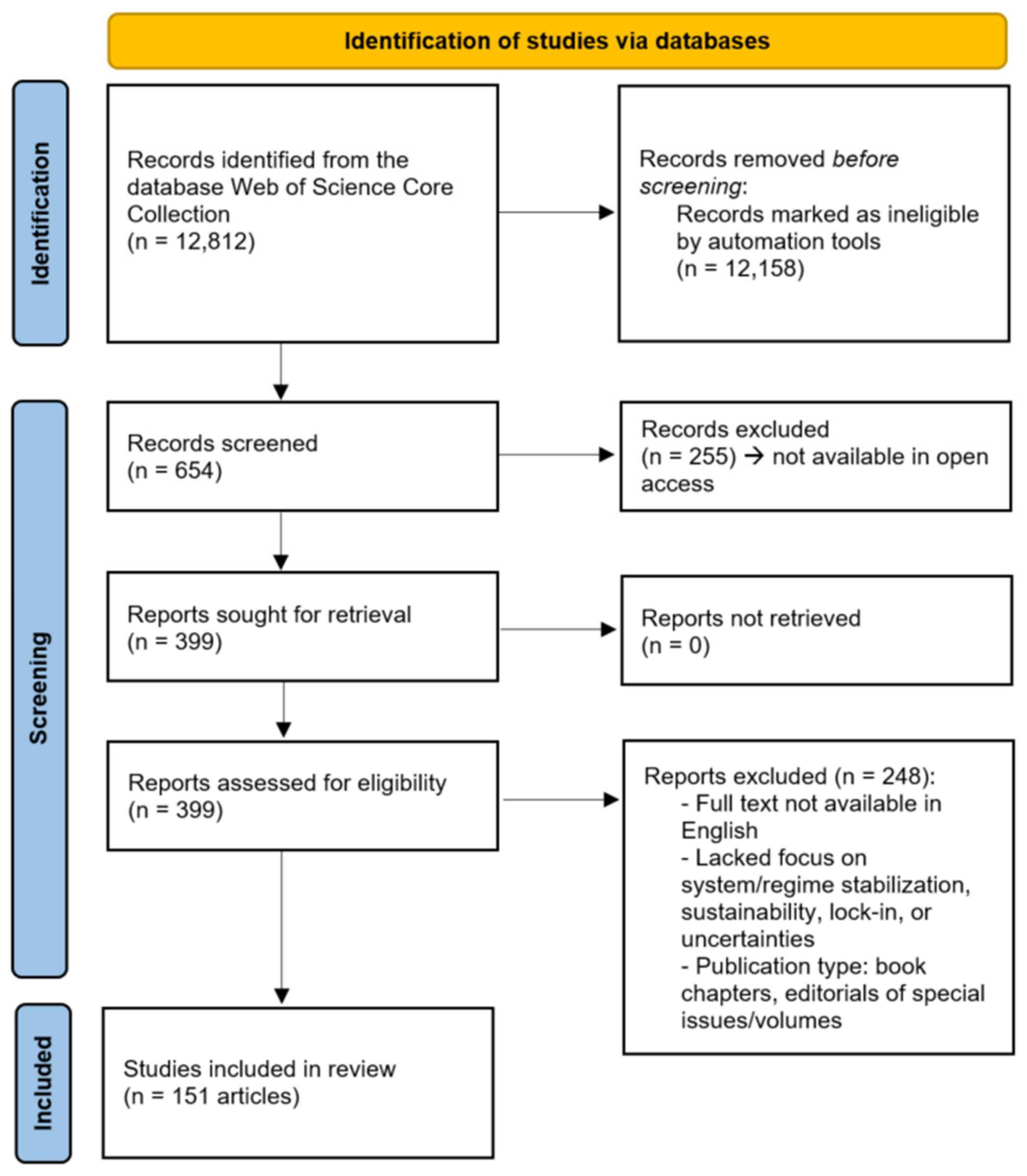
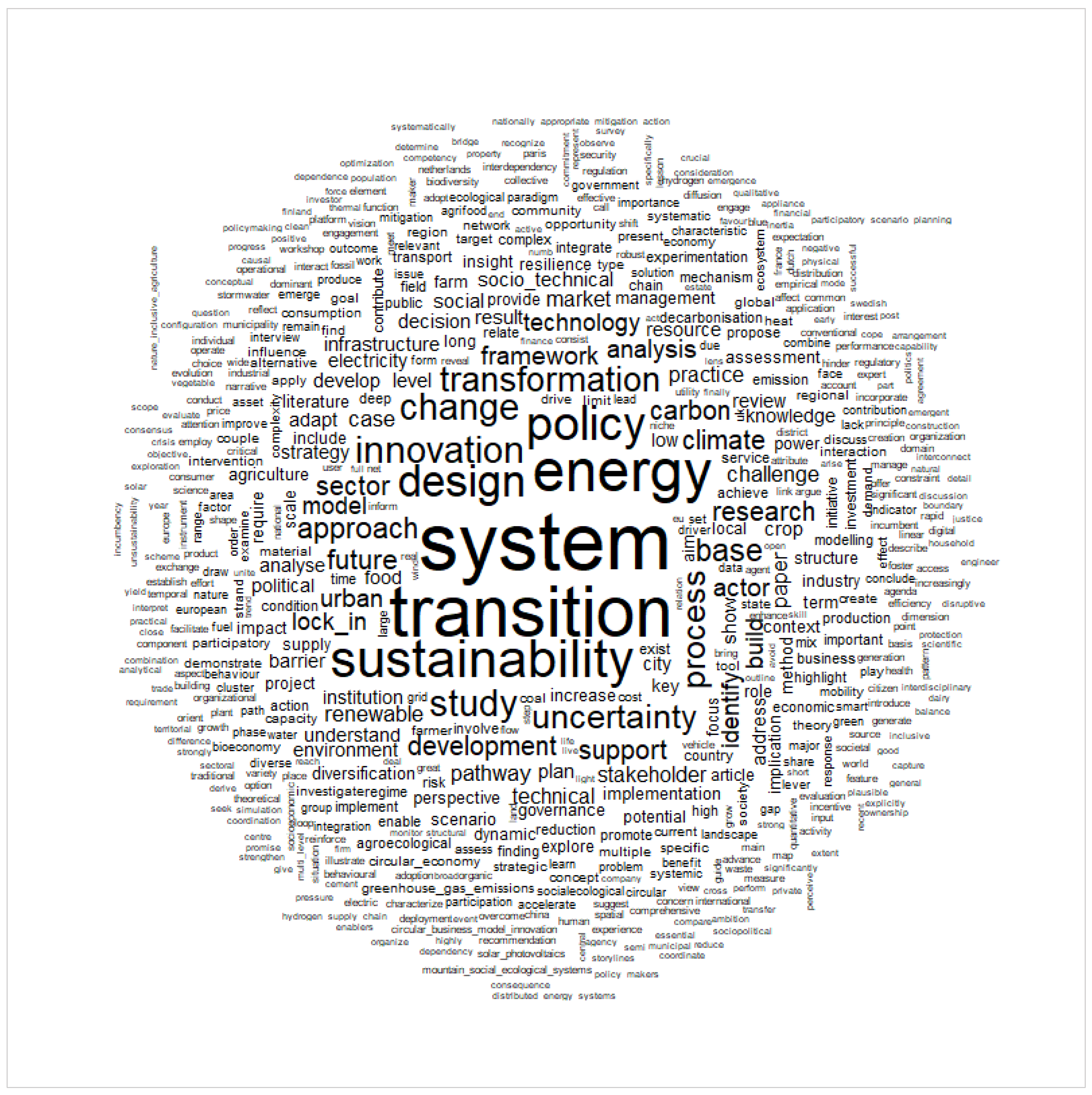
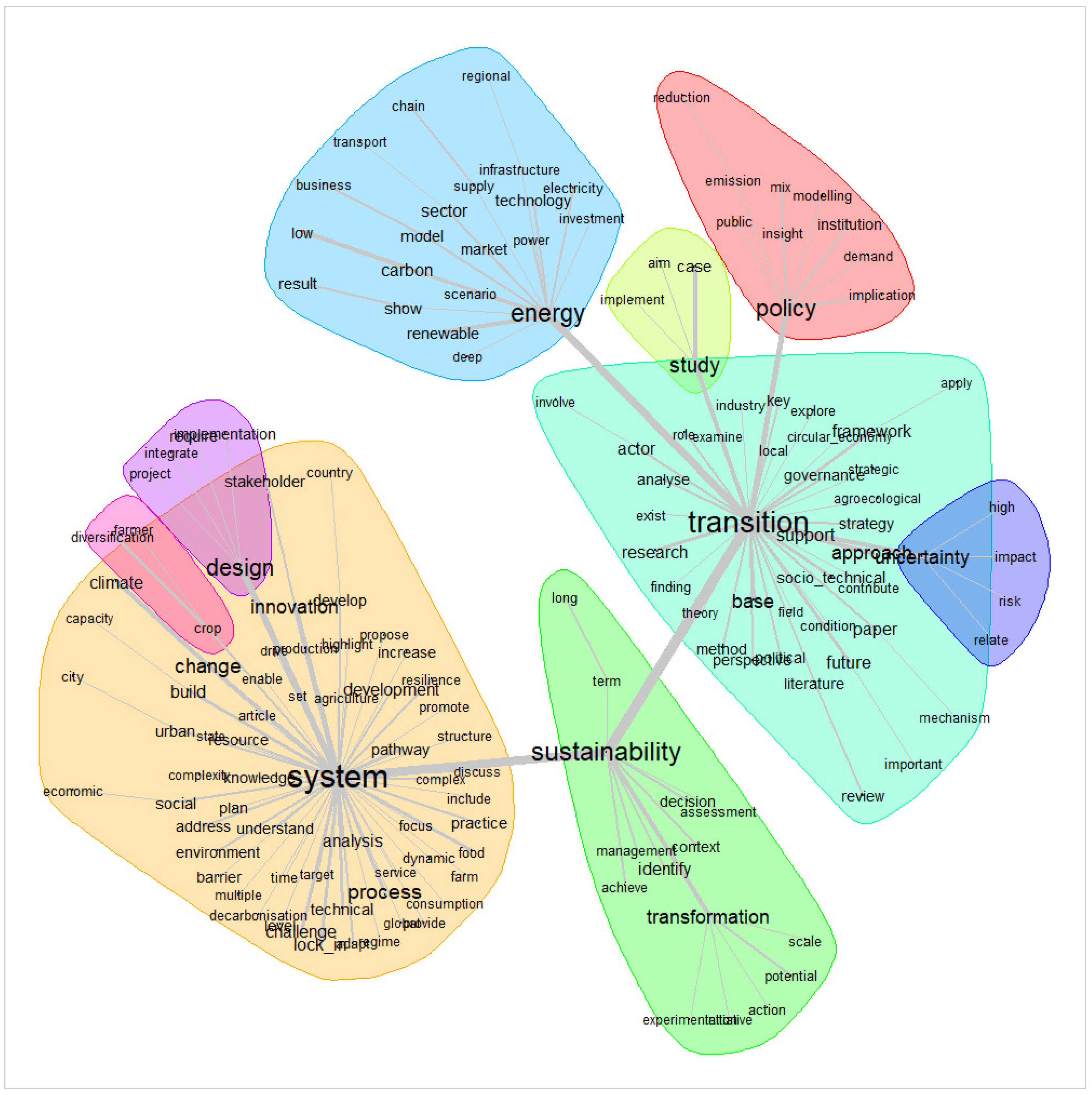
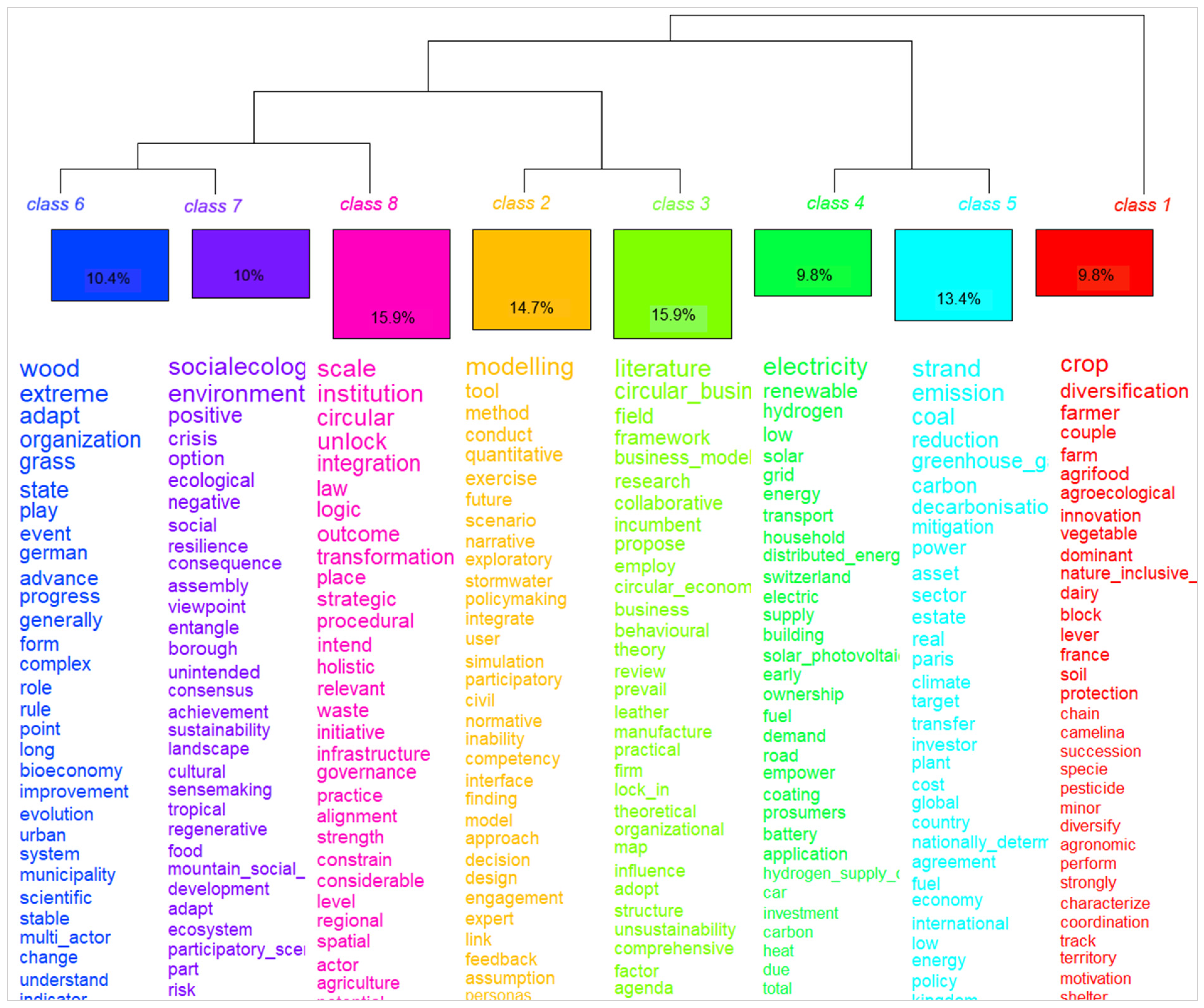




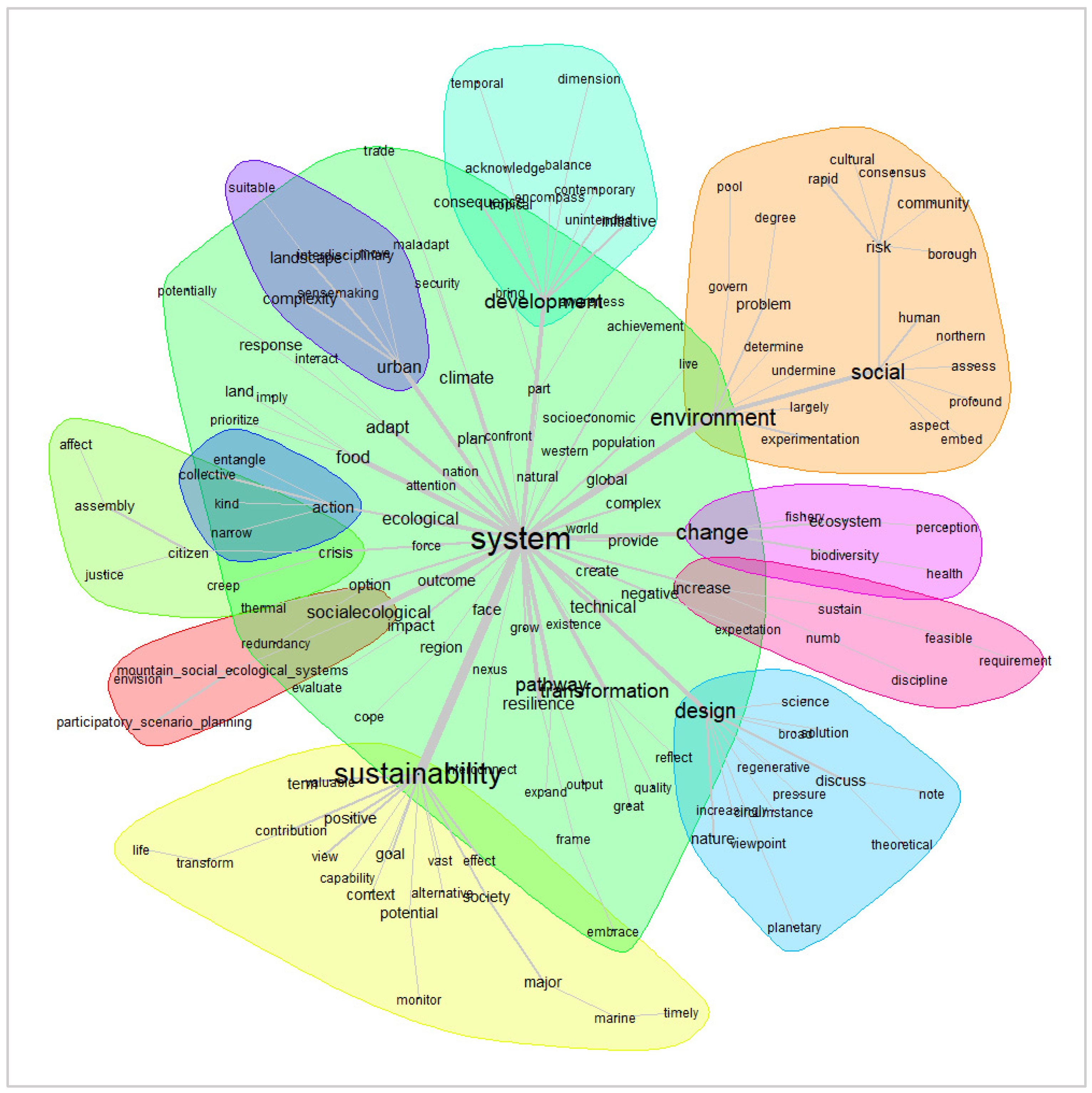
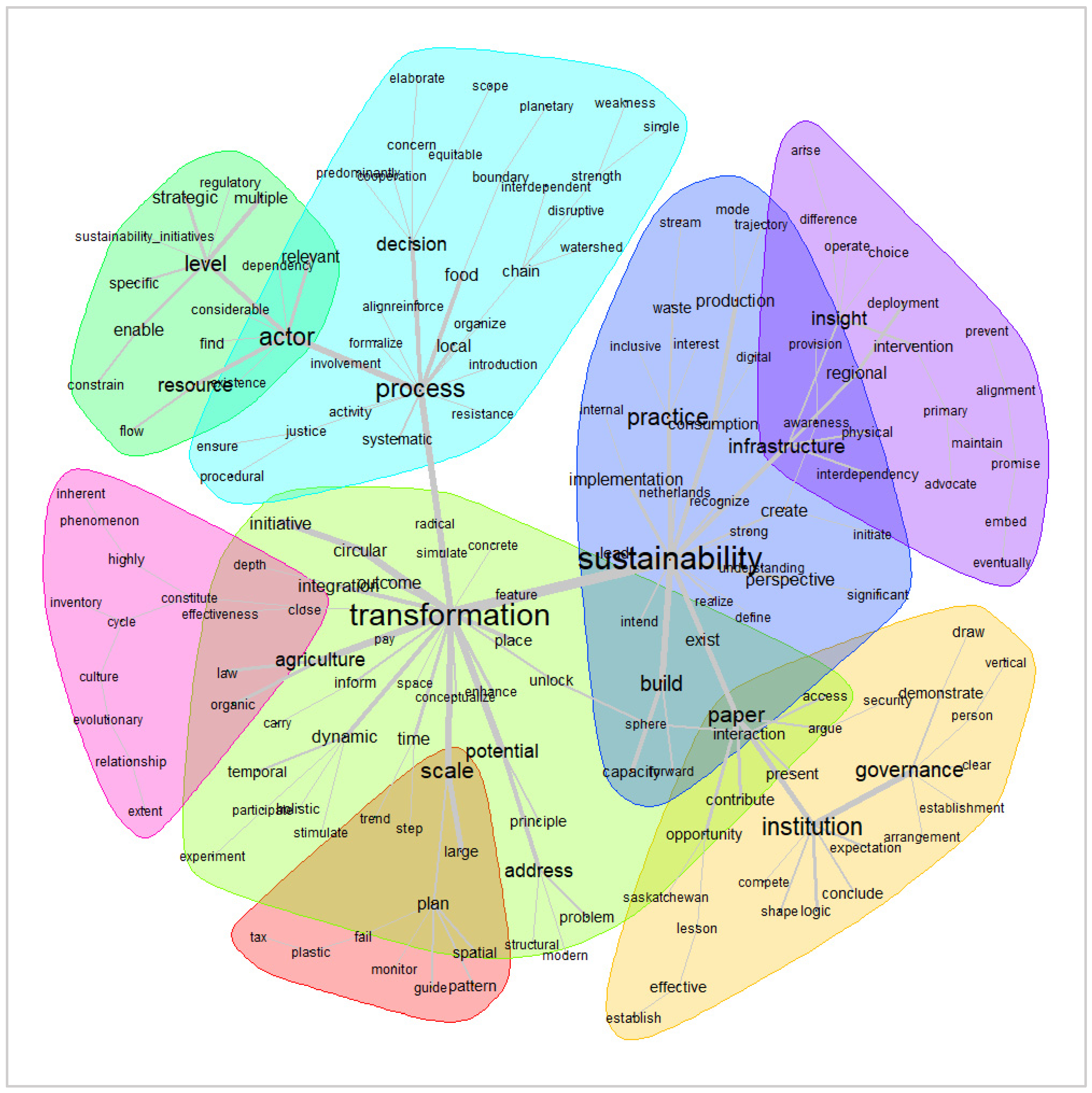
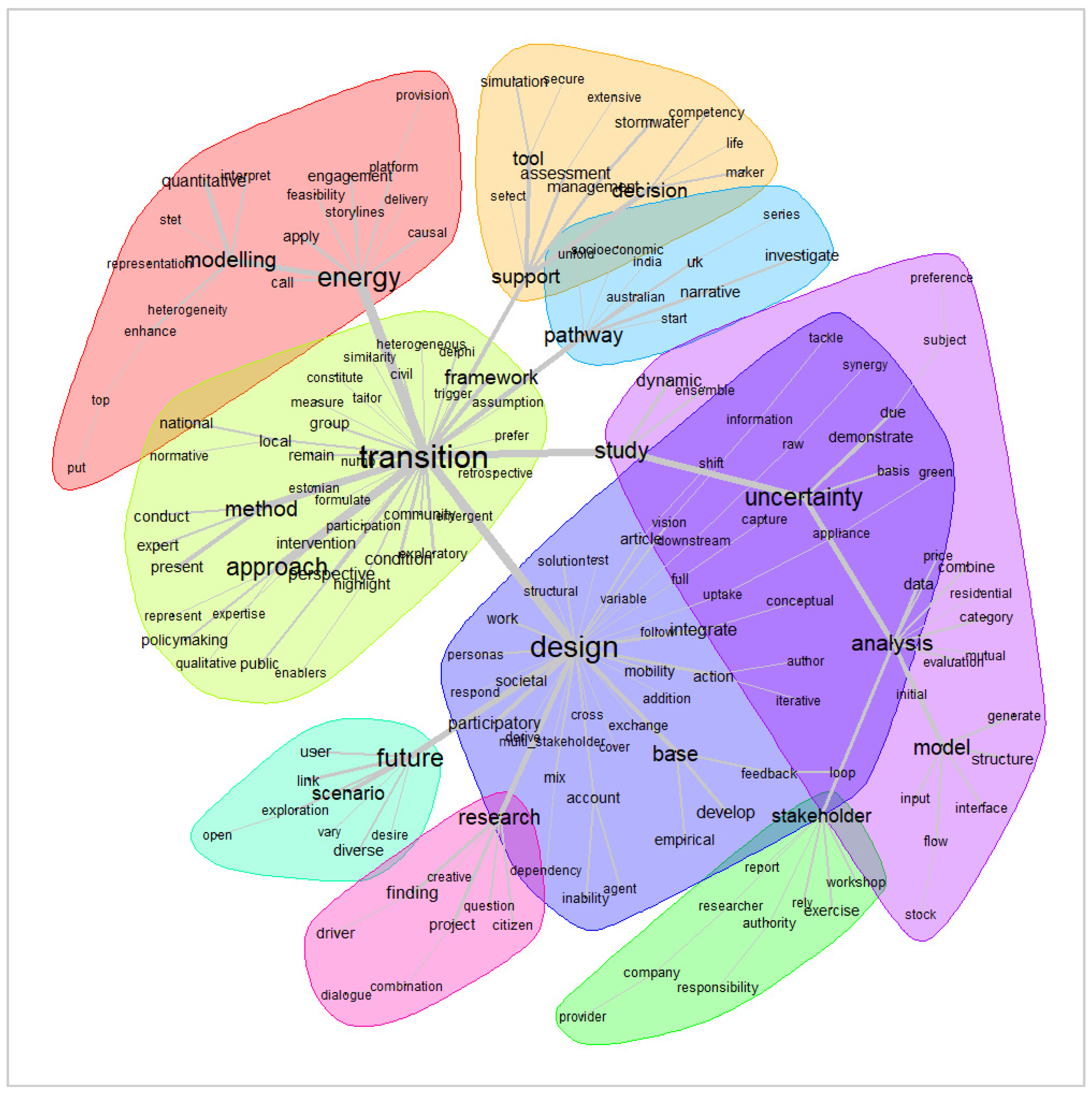
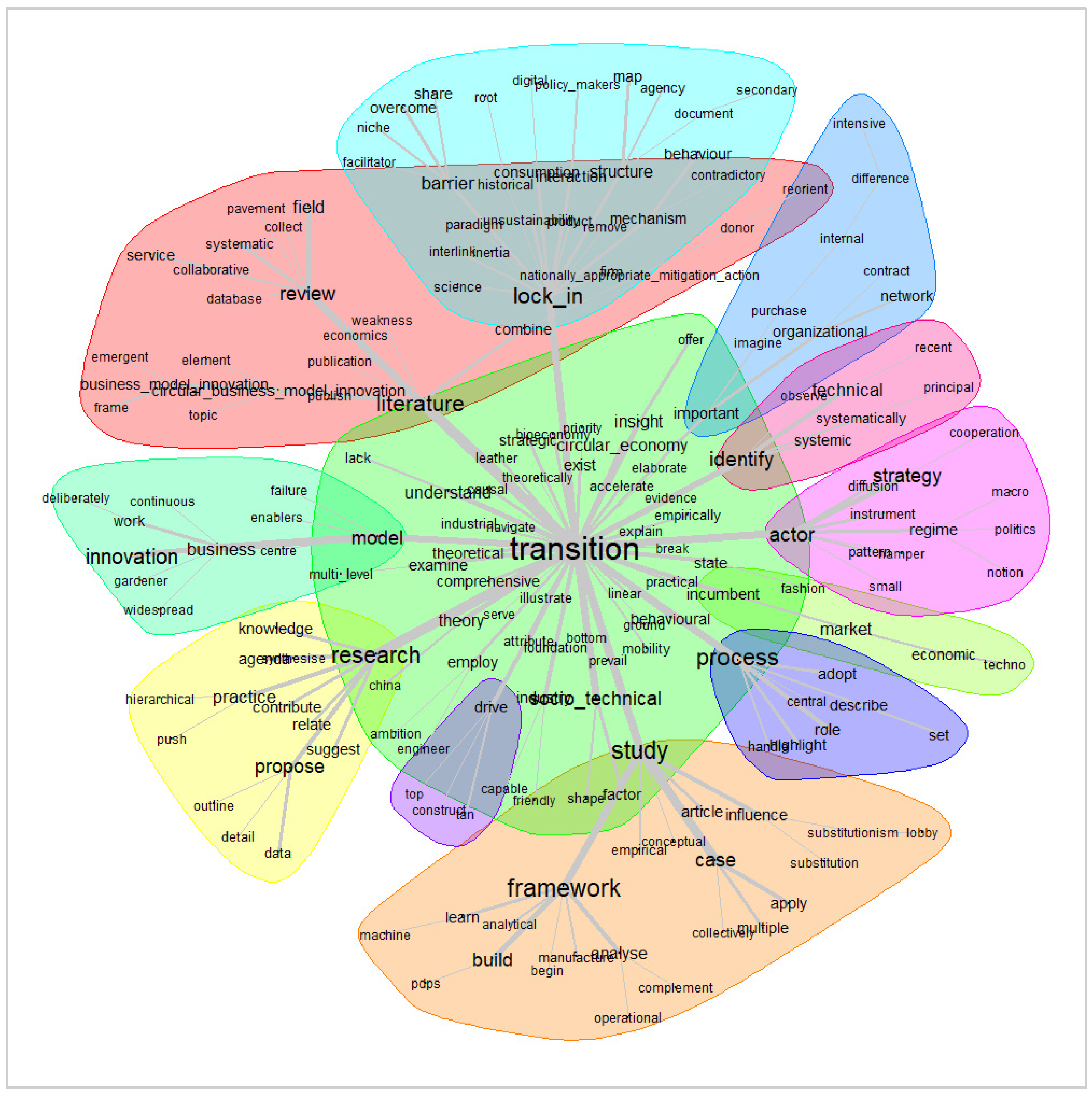
| 1 | system | 389 | 18 | development | 102 | 35 | case | 77 |
| 2 | transition | 337 | 19 | support | 101 | 36 | practice | 74 |
| 3 | energy | 276 | 20 | research | 100 | 37 | technical | 73 |
| 4 | sustainability | 237 | 21 | carbon | 98 | 38 | stakeholder | 70 |
| 5 | policy | 215 | 22 | actor | 95 | 39 | market | 70 |
| 6 | design | 196 | 23 | analysis | 93 | 40 | socio_technical | 68 |
| 7 | innovation | 155 | 24 | framework | 92 | 41 | result | 68 |
| 8 | change | 153 | 25 | urban | 92 | 42 | plan | 68 |
| 9 | study | 152 | 26 | lock_in | 88 | 43 | level | 67 |
| 10 | transformation | 146 | 27 | model | 87 | 44 | social | 66 |
| 11 | uncertainty | 139 | 28 | identify | 85 | 45 | crop | 66 |
| 12 | process | 135 | 29 | build | 84 | 46 | decision | 66 |
| 13 | base | 125 | 30 | technology | 83 | 47 | infrastructure | 65 |
| 14 | approach | 112 | 31 | paper | 80 | 48 | show | 64 |
| 15 | future | 107 | 32 | renewable | 79 | 49 | develop | 62 |
| 16 | climate | 104 | 33 | pathway | 79 | 50 | food | 61 |
| 17 | sector | 103 | 34 | challenge | 78 |
| Key Text Segments | Year | Theme | Score |
|---|---|---|---|
| Organic mulching cropping system combined with on farm organic mulch production farm coupled innovation crop diversification combined with plot exchange with neighbouring farmer coupled innovation and making soil health status explicitly transparent in field transactions combined with agroecological soil health management agrifood system coupled innovations | 2023 | Food | 1396.35 |
| Tracking down coupled innovations supporting agroecological vegetable crop protection to foster sustainability transition of agrifood systems high pesticide use causes environment and human health hazards yet the change to alternative crop protection practices faces a web of interacting barriers that results in a socio_technical lock_in | 2022 | Food | 1042.37 |
| Our results indicate that support to crop diversification should be tailored according to farmers agronomic economic and work related issues especially at the level of the crop succession and the farm | 2022 | Food | 1007.52 |
Disclaimer/Publisher’s Note: The statements, opinions and data contained in all publications are solely those of the individual author(s) and contributor(s) and not of MDPI and/or the editor(s). MDPI and/or the editor(s) disclaim responsibility for any injury to people or property resulting from any ideas, methods, instructions or products referred to in the content. |
© 2025 by the authors. Licensee MDPI, Basel, Switzerland. This article is an open access article distributed under the terms and conditions of the Creative Commons Attribution (CC BY) license (https://creativecommons.org/licenses/by/4.0/).
Share and Cite
Hamman, P.; Schneider, P.; Monicolle, C. Beyond Innovation Niches: A Social Sciences Review of System Building Perspectives in Sustainability Transitions. Societies 2025, 15, 312. https://doi.org/10.3390/soc15110312
Hamman P, Schneider P, Monicolle C. Beyond Innovation Niches: A Social Sciences Review of System Building Perspectives in Sustainability Transitions. Societies. 2025; 15(11):312. https://doi.org/10.3390/soc15110312
Chicago/Turabian StyleHamman, Philippe, Patricia Schneider, and Céline Monicolle. 2025. "Beyond Innovation Niches: A Social Sciences Review of System Building Perspectives in Sustainability Transitions" Societies 15, no. 11: 312. https://doi.org/10.3390/soc15110312
APA StyleHamman, P., Schneider, P., & Monicolle, C. (2025). Beyond Innovation Niches: A Social Sciences Review of System Building Perspectives in Sustainability Transitions. Societies, 15(11), 312. https://doi.org/10.3390/soc15110312





